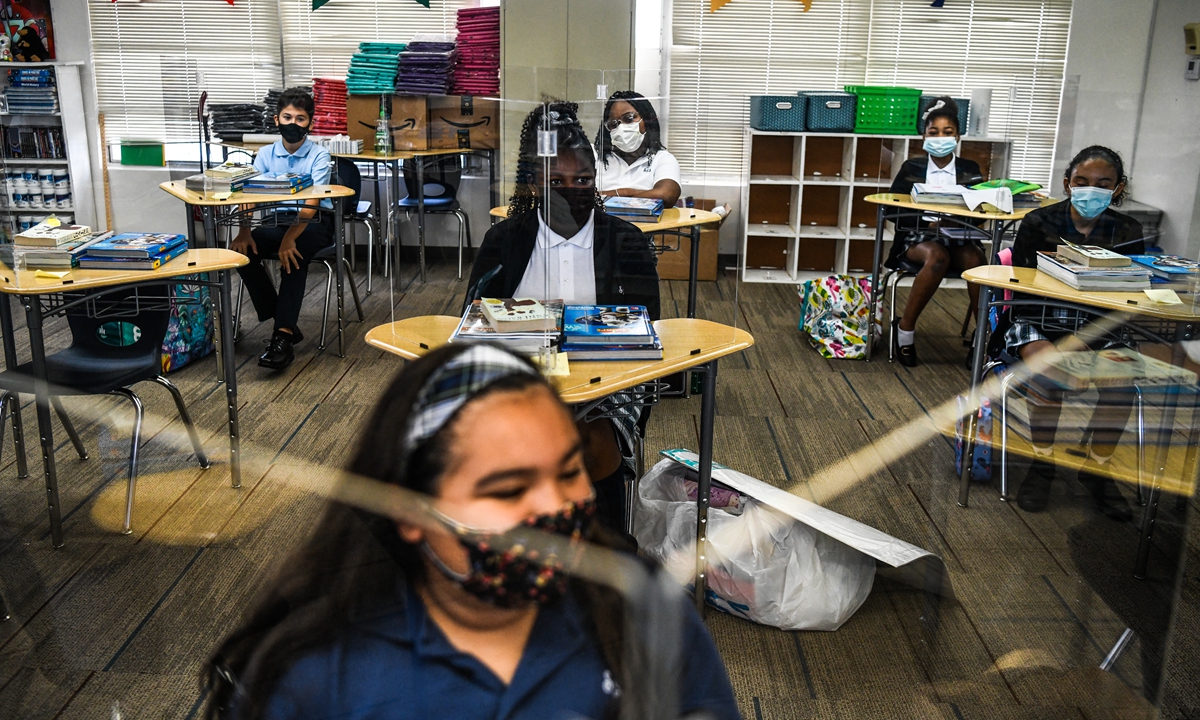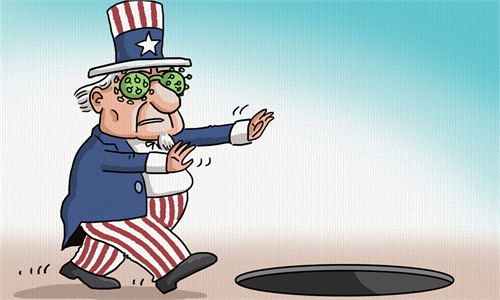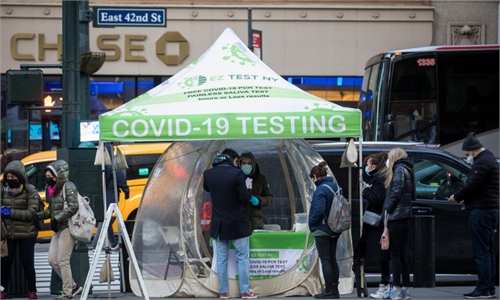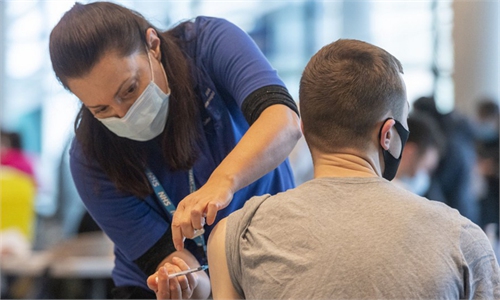
Student wear facemasks as they attend their first day in school after summer vacation at the St. Lawrence Catholic School in north of Miami, on August 18, 2021. Photo: AFP
Results from the National Assessment of Educational Progress, commonly referred to as the US' "national report card," suggest that the ongoing COVID-19 epidemic has caused serious learning setbacks for American students. Across the country, math scores saw their largest decrease on record and reading scores dropped to 1992 levels. Nearly 40 percent of eighth graders demonstrated a lack of ability to grasp basic math concepts and no state saw improvements in their average test scores.This was the first such assessment in the pandemic era, considered the first nationally representative benchmark of how the country's educational system has endured the coronavirus. Education Secretary Miguel Cardona reacted bluntly to this, "Let me be very clear: These results are not acceptable," he said.
Much like the pandemic has entrenched inequities, test scores also show that Black and Hispanic students saw larger decreases compared to their white peers. As millions of students were forced to switch to at-home schooling, this set struggling students in more precarious domestic situations up for failure as they, on balance, had less reliable access to spaces and technology suitable for their educational needs.
The news is a massive hit against a nation already struggling to stay competitive on the international stage. US students are continually rated as far below peer countries in STEM fields (science, technology, engineering and mathematics), setting them up for less success later in their educational lives. This was reflected by relevant rankings in tertiary education.
It's important to note that the COVID-19 pandemic has not so much created new problems as it has inflated existing problems, like racial inequities and a lack of federal priorities geared toward students. This immediately calls into question existing government policy and a need for more investments in education, wealth redistribution and serious efforts to combat inequity and inequality.
At the same time, COVID-19 restrictions are not necessarily the problem. Keeping students in schools has been one of the main arguments used by certain sectors of the political spectrum to make a nationwide "lockdown" or ongoing pandemic-related non-pharmaceutical interventions (NPIs) untenable. Advocates say that the hits to student education are too great to implement serious strategies to mitigate the spread of the coronavirus, which is an argument that has gained serious traction over the years.
But this is misleading, because choosing between virus mitigation and student outcomes is not binary, much like economic outcomes. First of all, a lot of the basis of this argument has been that children are not as affected by the coronavirus - which is a line of reason that has been demonstrated false. Severe pediatric cases of COVID-19 are evident, as are related deaths, and the risk of long COVID-19 is shown to be at around 20 percent. Since we know that the coronavirus can cause brain damage and attendant learning disabilities, keeping kids in unsafe classrooms should be a non-starter.
That's why many experts have compared the prevalence of COVID-19 in the US to the current generation's cigarette smoke or leaded gasoline. These things caused serious negative health outcomes, especially for children, and were drastically reduced through government regulations after new information about their adverse effects poured in. It is to be hoped that eradicating COVID-19 might follow a similar path.
Similarly, keeping schools functioning as-is poses serious health risks to faculty and staff. Moreover, successive waves of the coronavirus have often left schools inactive during peaks because of staff shortages. Since the virus is becoming more transmissible as it mutates, this issue is becoming more and more salient which is why the Centers for Disease Control and Prevention (CDC) notoriously updated its isolation and quarantine guidelines to help critical industries function in the event of rising infections in the workforce.
This is why, rather than letting the virus roam freely, the end goal should be mitigation or outright eradication of the virus.
One expert on immunology, Dr. Anthony J. Leonardi, argued in an open letter that remote learning is desirable since there is no way to guarantee a totally safe learning environment. However, he argues that in cases where this is not possible, schools could implement masking policies and proper air filtration. It has long been established that COVID-19 is airborne, which demands a change in the ways in which NPIs are implemented to mitigate the spread of the disease.
Of course, policymakers will need a lot of political will to update school infrastructure to ensure adequate air quality controls. But this is a small price to pay for the country's educational future. One thing's for sure, however, and that is that educational outcomes and public health are not either/or; they are, in fact, inexplicably tied.
The author is a Prague-based American journalist, columnist and political commentator. opinion@globaltimes.com.cn




